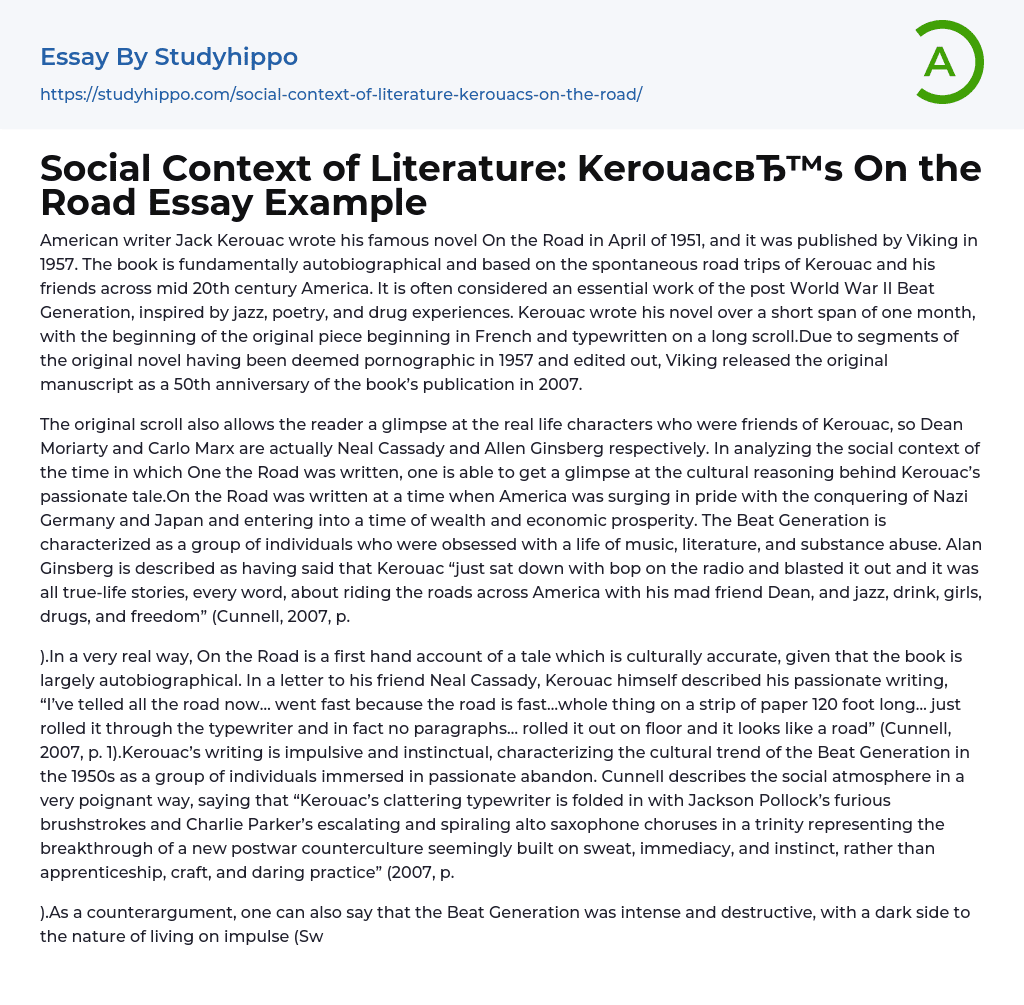

Social Context of Literature: Kerouac’s On the Road Essay Example
American writer Jack Kerouac wrote his famous novel On the Road in April of 1951, and it was published by Viking in 1957. The book is fundamentally autobiographical and based on the spontaneous road trips of Kerouac and his friends across mid 20th century America. It is often considered an essential work of the post World War II Beat Generation, inspired by jazz, poetry, and drug experiences. Kerouac wrote his novel over a short span of one month, with the beginning of the original piece beginning in French and typewritten on a long scroll.Due to segments of the original novel having been deemed pornographic in 1957 and edited out, Viking released the original manuscript as a 50th anniversary of the book’s publication in 2007.
The original scroll also allows the reader a glimpse at the rea
...l life characters who were friends of Kerouac, so Dean Moriarty and Carlo Marx are actually Neal Cassady and Allen Ginsberg respectively. In analyzing the social context of the time in which One the Road was written, one is able to get a glimpse at the cultural reasoning behind Kerouac’s passionate tale.On the Road was written at a time when America was surging in pride with the conquering of Nazi Germany and Japan and entering into a time of wealth and economic prosperity. The Beat Generation is characterized as a group of individuals who were obsessed with a life of music, literature, and substance abuse. Alan Ginsberg is described as having said that Kerouac “just sat down with bop on the radio and blasted it out and it was all true-life stories, every word, about riding the roads across Americ
with his mad friend Dean, and jazz, drink, girls, drugs, and freedom” (Cunnell, 2007, p.
).In a very real way, On the Road is a first hand account of a tale which is culturally accurate, given that the book is largely autobiographical. In a letter to his friend Neal Cassady, Kerouac himself described his passionate writing, “I’ve telled all the road now… went fast because the road is fast…whole thing on a strip of paper 120 foot long… just rolled it through the typewriter and in fact no paragraphs… rolled it out on floor and it looks like a road” (Cunnell, 2007, p. 1).Kerouac’s writing is impulsive and instinctual, characterizing the cultural trend of the Beat Generation in the 1950s as a group of individuals immersed in passionate abandon. Cunnell describes the social atmosphere in a very poignant way, saying that “Kerouac’s clattering typewriter is folded in with Jackson Pollock’s furious brushstrokes and Charlie Parker’s escalating and spiraling alto saxophone choruses in a trinity representing the breakthrough of a new postwar counterculture seemingly built on sweat, immediacy, and instinct, rather than apprenticeship, craft, and daring practice” (2007, p.
).As a counterargument, one can also say that the Beat Generation was intense and destructive, with a dark side to the nature of living on impulse (Swartz, 1999, p. xi). Rejecting all social constraints, members of the Beat Generation like Jack Kerouac were obsessed with the extremely individualist idea of living on the edge and living for oneself.
- Book Summary essays
- Metaphor essays
- Reader essays
- Rhyme essays
- Literary devices essays
- Villain essays
- Books essays
- Genre essays
- Literary Criticism essays
- Writer essays
- Protagonist essays
- Simile essays
- Poem essays
- Book Report essays
- Book Review essays
- Greek Mythology essays
- Plot essays
- Tragic Hero essays
- Coming of Age essays
- Play essays
- Rhetoric essays
- Rhetorical Question essays
- Translation essays
- Understanding essays
- Reason essays
- Character essays
- Letter essays
- American Literature essays
- Literature Review essays
- Utopia essays
- Poetry Analysis essays
- Dante's Inferno essays
- Between The World and Me essays
- Incidents in The Life of a Slave Girl essays
- Flowers for Algernon essays
- Myth essays
- Everyday Use essays
- Boo Radley essays
- Genesis essays
- Richard iii essays
- Alice in Wonderland essays
- On the road essays
- Ozymandias essays
- The Nightingale essays
- Holden Caulfield essays
- Animal Farm essays
- 1984 essays
- A Hanging essays
- Shooting An Elephant essays
- A Tale Of Two Cities essays



